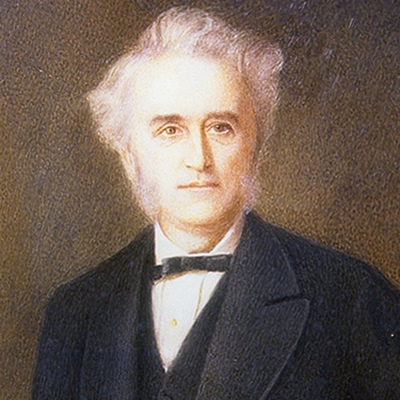John Langdon Down (1828-1896)

John Langdon Down was born at Torpoint, Cornwall in 1828. After local schooling he was apprenticed at the age of 14 to his father, the village apothecary at Anthony St. Jacob’s. In 1846 he entered a laboratory of the Pharmaceutical Society, and won a prize for organic chemistry.
Down had wanted to be a doctor after his first encounter with a child with Down’s Syndrome when he was 18, but his father was against it. After his father died in 1853, he entered the Medical School of the London Hospital. While in medical school, he stayed with his sister and met her sister in law, his future wife Mary. Graduating summa cum laude with gold medals in Medicine, Surgery, and Obstetrics, he took a newly created position as Chief Physician of the Royal Earlswood Asylum of Idiots in 1858, and set about improving the notoriously poor care there. Under his new policies, the Earlswood Asylum became an exemplary institution, was described in an article in Lancet, and was widely admired.
Down took photographs of all the patients and tried to classify them using the racial groups of Blumenbach. He found the largest group of patients fit into what Blumenbach called the “Mongolian family,’ with round face, oblique eyes, flat nape, short bristly hair, small pug nose, thick cleaved tongue, and so on, and published the first complete description of the syndrome in 1866.* The term “Mongoloid” was still widely in use until recent times. After some conflicts over funding with the Lords of Earlswood, including their refusal to pay his wife for her work at the Asylum, Down resigned from the position in 1868.
Down was a member of the Royal College of Physicians and could have practiced as a fulltime physician and surgeon, but was still determined to improve the welfare of “Mongol” children. He found funding to create a home for the mentally disabled, which he named Normansfield, and to keep everything affordable he decided to start with a dozen children of rich Lords. Down and operated the home together with his wife Mary and it was so successful it soon had to be expanded, eventually reaching 160 beds. He overcame the prejudices of the time which said these children could not learn anything, and pioneered in teaching the children crafts and hobbies and how to eat, and training them to ride a horse, clean stables, grow vegetables and fruit, collect eggs, and milk cows.
John and Mary had two sons, both of whom became doctors and continued his work at Normansfeld after he died in 1896at the age of 67 years. The cause of the syndrome was shown by Lejeune to be Trisomy 21 in 1959. “Mongolism” remained an accepted term until 1960. In 1961, genetics experts wrote an open letter to Lancet discouraging use of the racist term because there was no association of the syndrome with normal Asian genes. One of the signatories to the letter approached John Langdon Down’s grandson, who was still the head of Normansfield, and asked if his family name could be used for the syndrome. The grandson agreed, and the WHO confirmed the eponym “Down’s Syndrome” in 1965.
* JLH Down (1866). “Observations on an ethnic classification of idiots”. Clinical Lecture Reports, London Hospital. 3: 259–262.
- John Langdon Down (1828-1896) and “Mongolism” by P. M. Dunn, Archives of Diseases in Children, 1991.
- John Langdon Down (Wikipedia)
Last Updated on 07/22/23